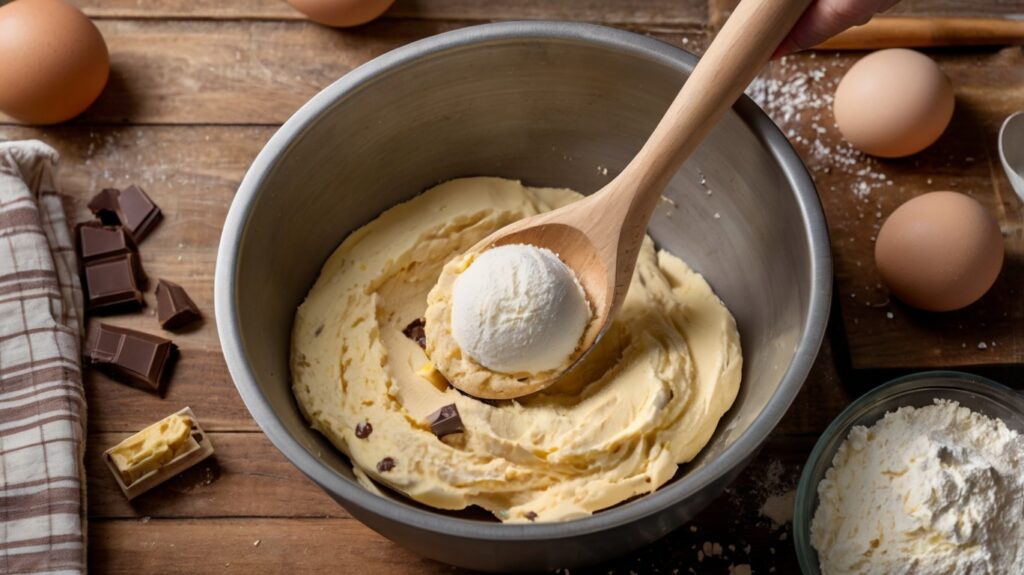Table of Contents
Introduction to the Perfect Cookie Dough Recipe

A perfect cookie dough recipe is every baker’s secret weapon. Whether you’re preparing to bake cookies or enjoy the dough raw, having a versatile and reliable cookie dough recipe in your kitchen is a must. This guide will walk you through creating the ideal cookie dough recipe, ensuring it is safe to eat, delicious, and easy to prepare.
Different Types of Cookie Dough Recipes

Understanding the different types of cookie dough_recipes is crucial for creating the perfect batch. Here are the most popular types:
- Traditional Cookie Dough_Recipe: This dough is used for baking cookies and includes ingredients like flour, sugar, butter, and eggs. It serves as the base for many variations.
- Edible Cookie Dough Recipe: Specifically designed to be consumed raw, this dough excludes raw eggs and uses heat-treated flour to ensure safety. If you’re looking for more ideas on how to make edible versions, check out our guide on the safe handling of cookie dough.
- Vegan and Gluten-Free Cookie Dough Recipe: These versions replace traditional ingredients with options like almond flour and flaxseed eggs for those with dietary restrictions. More details can be found in our vegan and gluten-free baking guide.
Essential Ingredients for a Cookie Dough Recipe
To craft the perfect cookie dough recipe, start with high-quality ingredients. Here’s what you need:

- Flour: This is the backbone of any cookie dough recipe. While all-purpose flour is the standard, alternatives like almond or oat flour can be used for gluten-free versions.
- Sugars: A mix of white and brown sugars is often used to add sweetness and moisture. Brown sugar contributes a hint of molasses flavor, which enhances the dough.
- Fats: Butter is a common fat in cookie dough_recipes, but margarine or coconut oil are also suitable alternatives.
- Eggs: Eggs provide moisture and act as a binding agent in the dough. Vegan substitutes, such as flaxseed meal or chia seeds mixed with water, can replace eggs.
- Flavorings: Vanilla extract is a must for most cookie dough recipes, adding depth to the flavor. Salt is also essential to balance the sweetness, and add-ins like chocolate chips or nuts make the dough more interesting.
How to Make a Classic Cookie Dough Recipe
Follow these steps for a simple yet delicious cookie_dough recipe:

- Cream the Butter and Sugars: Combine softened butter with white and brown sugars in a mixing bowl. Beat until light and fluffy to create a creamy base for your dough.
- Add the Eggs and Vanilla: Mix in the eggs one at a time, ensuring they are fully incorporated. Add vanilla extract for flavor.
- Mix in the Dry Ingredients: Gradually add flour, baking soda, and salt to the mixture. Mix just until combined to avoid overworking the dough.
- Fold in Your Favorite Mix-Ins: Add chocolate chips, nuts, or other mix-ins. Gently fold them into the dough to distribute evenly.
- Chill the Dough: Chilling the dough for at least an hour before baking enhances the flavors and texture, preventing cookies from spreading too much.
Popular Variations of Cookie Dough Recipes

- Chocolate Chip Cookie Dough Recipe: Add a generous amount of semi-sweet chocolate chips for a classic taste.
- Peanut Butter Cookie Dough Recipe: Incorporate creamy peanut butter to give your dough a rich, nutty flavor.
- Oatmeal Raisin Cookie Dough_Recipe: Mix in oats and raisins for a wholesome and chewy texture.
- Sugar Cookie Dough Recipe for Cut-Outs: A firmer dough that holds its shape, perfect for making decorative cut-out cookies.
- Edible Cookie Dough Recipe: Safe to eat raw, this dough omits eggs and uses heat-treated flour, making it ideal for a quick, sweet snack.
Creative Mix-Ins and Flavors for Cookie Dough Recipes
Adding different mix-ins and flavors can make a simple cookie dough recipe more exciting:
- Candy Pieces and Nuts: Enhance the texture and flavor with additions like chocolate candies, peanut butter cups, or chopped nuts.
- Dried Fruits: Include dried fruits like cranberries, cherries, or apricots for a chewy and flavorful twist.
- Spices: Cinnamon, nutmeg, or even ginger can add warmth and complexity to your cookie dough recipe.
- Extracts and Zests: Try using almond extract, peppermint extract, or citrus zest to elevate the flavor profile.
Tips for Storing and Freezing Cookie Dough Recipes
Proper storage ensures that your cookie dough recipe stays fresh and ready to use whenever you want:
- Refrigeration: Store cookie dough in an airtight container in the refrigerator for up to a week. Chilling the dough also helps develop flavor.
- Freezing: To save dough for future use, freeze it. Shape the dough into balls or logs, wrap it in plastic wrap, and store it in freezer bags. Frozen cookie dough can last up to three months.
- Thawing and Baking: When ready to bake, thaw the frozen dough in the refrigerator. This helps retain the dough’s texture and ensures even baking.
Frequently Asked Questions (FAQs)
- Can you eat cookie dough raw? Traditional cookie dough recipes with raw eggs and flour are safe to eat raw. Use edible versions made with safe ingredients.
- How do you know when cookie dough is ready to bake? The dough should be firm and not overly sticky. Chilling the dough before baking helps achieve the right consistency.
- What can I substitute for eggs in a cookie dough recipe? Use flaxseed meal mixed with water, applesauce, or mashed bananas as egg substitutes.
- Why is my cookie dough too sticky or dry? Adjust the flour or liquid content accordingly. Add more flour if it’s too sticky or a bit of milk or melted butter if it’s too dry.
- How can I make my cookie dough more flavorful? Enhance flavor by using high-quality vanilla extract, experimenting with different sugars, or adding a pinch of sea salt.
- What makes cookie dough?
- What are the three types of cookie dough?
- What is the difference between cookie batter and cookie dough?
- What are the 15 common mistakes in making cookie dough?
Conclusion
Creating the perfect cookie dough recipe is both an art and a science. Whether you’re baking cookies or enjoying the dough raw, experimenting with flavors and mix-ins is key to finding your favorite cookie dough recipe. With these tips and techniques, you can master the art of cookie dough and delight your friends and family with delicious homemade treats. Happy baking!




